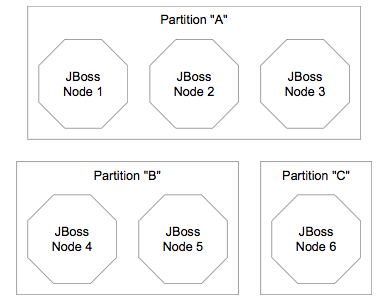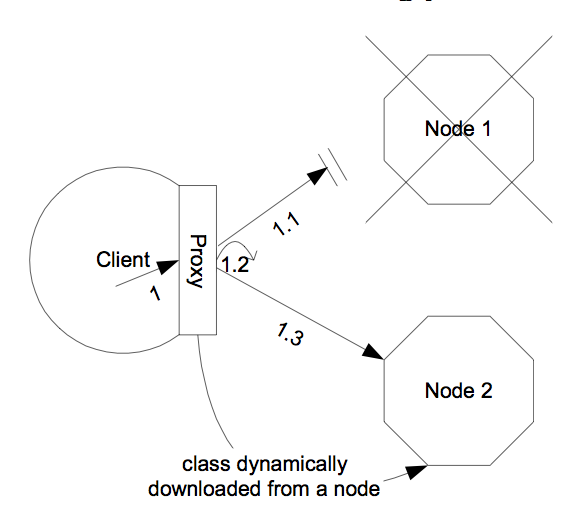In the next section, we discuss basic concepts behind JBoss' clustering services. It is helpful that you understand these concepts before reading the rest of the Clustering Guide.
A cluster is a set of nodes that communicate with each other and work
toward a common goal. In a JBoss Application Server cluster (also known
as a “partition”), a node is an JBoss Application Server instance.
Communication between the nodes is handled by the JGroups group communication
library, with a JGroups Channel providing the core functionality of tracking
who is in the cluster and reliably exchanging messages between the cluster
members. JGroups channels with the same configuration and name have the
ability to dynamically discover each other and form a group. This is why
simply executing “run -c all” on two AS instances on the same network is
enough for them to form a cluster – each AS starts a Channel (actually,
several) with the same default configuration, so they dynamically discover
each other and form a cluster. Nodes can be dynamically added to or removed
from clusters at any time, simply by starting or stopping a Channel with a
configuration and name that matches the other cluster members.
On the same AS instance, different services can create their own Channel,
and sometimes more than one. In a standard startup of the AS 5 all configuration,
two different services create a total of four different channels – JBoss
Messaging creates two and a core general purpose clustering service known
as HAPartition creates two more. If you deploy clustered web applications,
clustered EJB3 SFSBs or a clustered JPA/Hibernate entity cache, additional
channels will be created. The channels the AS connects can be divided into
three broad categories: a general purpose channel used by the HAPartition
service, channels created by JBoss Cache for special purpose
caching and cluster wide state replication, and two channels used by
JBoss Messaging.
So, if you go to two AS 5.x instances and execute run -c all,
the channels created on each server will discover each other and you'll have
a conceptual cluster. It's easy to think of this as a two node
cluster, but it's important to understand that you really have multiple channels,
and hence multiple two node clusters. With JBoss AS, it's the services that
form clusters, not the servers.
On the same network, you may have different sets of servers whose
services wish to cluster.
Figure 2.1, “Clusters and server nodes” shows an example network of JBoss
server instances divided into three sets, with the third set only
having one node. This sort of topology can be set up simply by configuring
the AS instances such that within a set of nodes meant to form a cluster the
channel configurations and names match while they differ from any other
channels on the same network. The AS tries to make this is easy as possible,
such that servers that are meant to cluster only need to have the same values
passed on the command line to the -g (partition name) and
-u (multicast address) startup switches. For each set of
servers, different values should be chosen. The sections on “JGroups Configuration” and
“Isolating JGroups Channels” cover in detail how to configure the AS such
that desired peers find each other and unwanted peers do not.
The clustering topography defined by the JGroups configuration on each node is of great importance to system administrators. But for most application developers, the greater concern is probably the cluster architecture from a client application's point of view. Two basic clustering architectures are used with JBoss AS: client-side interceptors (a.k.a smart proxies or stubs) and external load balancers. Which architecture your application will use will depend on what type of client you have.
Most remote services provided by the JBoss application server, including JNDI, EJB, JMS, RMI and JBoss Remoting, require the client to obtain (e.g., to look up and download) a remote proxy object. The proxy object is generated by the server and it implements the business interface of the service. The client then makes local method calls against the proxy object. The proxy automatically routes the call across the network where it is invoked against service objects managed in the server. The proxy object figures out how to find the appropriate server node, marshal call parameters, un-marshall call results, and return the result to the caller client. In a clustered environment, the server-generated proxy object includes an interceptor that understands how to route calls to multiple nodes in the cluster.
The proxy's clustering logic maintains up-to-date knowledge about the cluster. For instance, it knows the IP addresses of all available server nodes, the algorithm to distribute load across nodes (see next section), and how to failover the request if the target node not available. As part of handling each service request, if the cluster topology has changed the server node updates the proxy with the latest changes in the cluster. For instance, if a node drops out of the cluster, each proxy is updated with the new topology the next time it connects to any active node in the cluster. All the manipulations done by the proxy's clustering logic are transparent to the client application. The client-side interceptor clustering architecture is illustrated in Figure 2.2, “The client-side interceptor (proxy) architecture for clustering”.
The HTTP-based JBoss services do not require the client to download anything. The client (e.g., a web browser) sends in requests and receives responses directly over the wire using the HTTP protocol). In this case, an external load balancer is required to process all requests and dispatch them to server nodes in the cluster. The client only needs to know how to contact the load balancer; it has no knowledge of the JBoss AS instances behind the load balancer. The load balancer is logically part of the cluster, but we refer to it as “external” because it is not running in the same process as either the client or any of the JBoss AS instances. It can be implemented either in software or hardware. There are many vendors of hardware load balancers; the mod_jk Apache module is an excellent example of a software load balancer. An external load balancer implements its own mechanism for understanding the cluster configuration and provides its own load balancing and failover policies. The external load balancer clustering architecture is illustrated in Figure 2.3, “The external load balancer architecture for clustering”.
A potential problem with an external load balancer architecture is that the load balancer itself may be a single point of failure. It needs to be monitored closely to ensure high availability of the entire cluster's services.
Both the JBoss client-side interceptor (stub) and load balancer use load balancing policies to determine to which server node a new request should be sent. In this section, let's go over the load balancing policies available in JBoss AS.
In JBoss AS 5, the following load balancing options are available when the client-side interceptor architecture is used. The client-side stub maintains a list of all nodes providing the target service; the job of the load balance policy is to pick a node from this list for each request. Each policy has two implementation classes, one meant for use by legacy services like EJB2 that use the legacy detached invoker architecture, and the other meant for services like EJB3 that use AOP-based invocations.
Round-Robin: each call is dispatched to a new node, proceeding sequentially through the list of nodes. The first target node is randomly selected from the list. Implemented by
org.jboss.ha.framework.interfaces.RoundRobin(legacy) andorg.jboss.ha.client.loadbalance.RoundRobin(EJB3).Random-Robin: for each call the target node is randomly selected from the list. Implemented by
org.jboss.ha.framework.interfaces.RoundRobin(legacy) andorg.jboss.ha.client.loadbalance.RoundRobin(EJB3).First Available: one of the available target nodes is elected as the main target and is thereafter used for every call; this elected member is randomly chosen from the list of members in the cluster. When the list of target nodes changes (because a node starts or dies), the policy will choose a new target node unless the currently elected node is still available. Each client-side proxy elects its own target node independently of the other proxies, so if a particular client downloads two proxies for the same target service (e.g., an EJB), each proxy will independently pick its target. This is an example of a policy that provides “session affinity” or “sticky sessions”, since the target node does not change once established. Implemented by
org.jboss.ha.framework.interfaces.FirstAvailable(legacy) andorg.jboss.ha.client.loadbalance.aop.FirstAvailable(EJB3).First Available Identical All Proxies: has the same behaviour as the "First Available" policy but the elected target node is shared by all proxies in the same client-side VM that are associated with the same target service. So if a particular client downloads two proxies for the same target service (e.g. an EJB), each proxy will use the same target. Implemented by
org.jboss.ha.framework.interfaces.FirstAvailableIdenticalAllProxies(legacy) andorg.jboss.ha.client.loadbalance.aop.FirstAvailableIdenticalAllProxies(EJB3).
New in JBoss 5 are a set of "TransactionSticky" load balance policies. These extend the standard policies above to add behavior such that all invocations that occur within the scope of a transaction are routed to the same node (if that node still exists). These are based on the legacy detached invoker architecture, so they are not available for AOP-based services like EJB3.
Transaction-Sticky Round-Robin: Transaction-sticky variant of Round-Robin. Implemented by
org.jboss.ha.framework.interfaces.TransactionStickyRoundRobin.Transaction-Sticky Random-Robin: Transaction-sticky variant of Random-Robin. Implemented by
org.jboss.ha.framework.interfaces.TransactionStickyRandomRobin.Transaction-Sticky First Available: Transaction-sticky variant of First Available. Implemented by
org.jboss.ha.framework.interfaces.TransactionStickyFirstAvailable.Transaction-Sticky First Available Identical All Proxies: Transaction-sticky variant of First Available Identical All Proxies. Implemented by
org.jboss.ha.framework.interfaces.TransactionStickyFirstAvailableIdenticalAllProxies.
Each of the above is an implementation of a simple interface; users are free to write their own implementations if they need some special behavior. In later sections we'll see how to configure the load balance policies used by different services.
As noted above, an external load balancer provides its own load balancing capabilities. What capabilities are supported depends on the provider of the load balancer. The only JBoss requirement is that the load balancer support “session affinity” (a.k.a. “sticky sessions”). With session affinitiy enabled, once the load balancer routes a request from a client to node A and the server initiates a session, all future requests associated with that session must be routed to node A, so long as node A is available.


